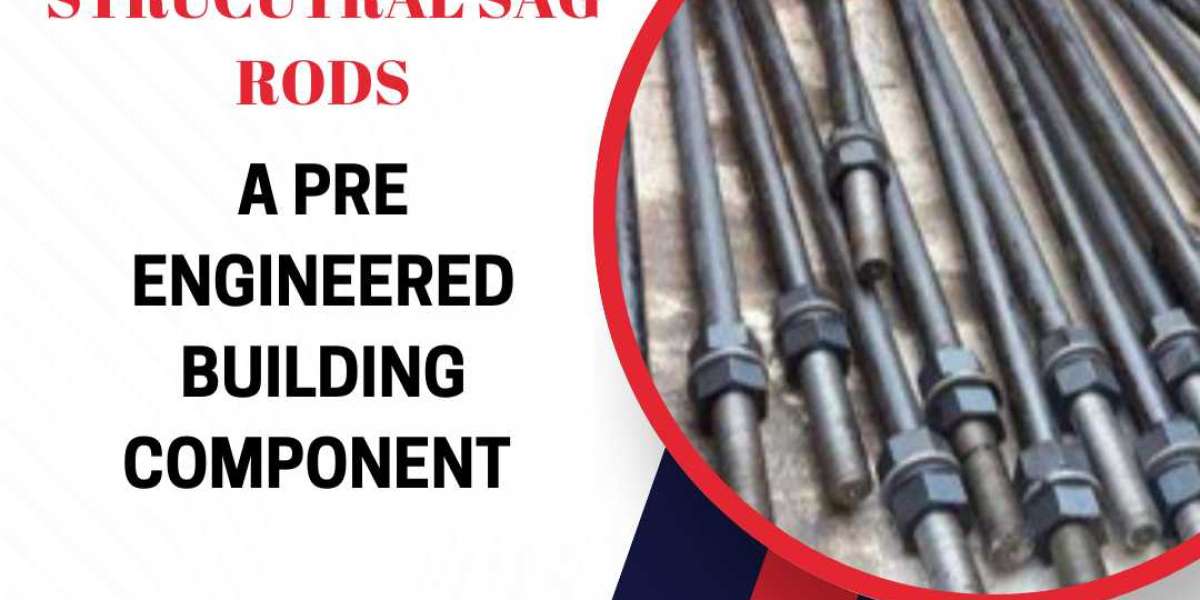What Are Sag Rods?
Sag rods are tension members that are employed in pre-engineered buildings to supply lateral support to purlins (roof members) and girts (wall members). They are mainly intended to resist sagging due to gravity, wind loads, and other external loads.
These are Constructed from high-strength steel and are generally fixed in a diagonal or horizontal formation between girts or purlins. Sag rods help with keeping things in line, reducing bending, and adding general strength to an industrial PEB system.
Functions of Sag Rods in PEB Buildings
In the case of Pre-Engineered Buildings (PEB), the sag rods serve a good number of functions:
- Sags and Deflections Prevention: The long, slender members like purlins and girders tend to sag under their own weight or loads applied to them; hence, the object of the sag rods is to prevent it from sagging and keep them straight and aligned.
- Improving Structural Stability: Sag rods stabilize pre-engineered structures by limiting excessive movement and laterally displacing the structures so that, over a period of time, there do not occur long-term deformations.
- Load Distribution Improvement: Sag rod installation, as accurately done, helps even distribution of load across the structure and eliminates stress points that might result in the failure of a PEB building. distribute loads evenly, reducing stress points that can lead to structural failure in a PEB building.
- Reducing Wind-induced vibrations In areas that wind, sagging rods substantially reduce vibrations, avoiding purlins and girts from fatigued and possible damage in industrial PEB solutions.
- Supporting Long-Span Structures Sagging rods provide the additional necessary reinforcement for long-span pre-engineered buildings so that the purlins and girders may easily span more without excessive bending.
Benefits of Using Sag Rods in PEB Solutions
- Economical Support
Sag rods provide better strength to the structure without making much difference to the overall cost of construction, thus holding a sound choice for PEB solutions.
- Lightweight and Save Space
Sag rods assist stability without added members, like adding extra steel beams, thus offering an efficient industrial PEB solution.
- Strong and Long-lasting
Since they are made from high-strength and durable steel, sag rods will interface with the harsh environmental conditions expected in an industrial PEB building.
- Rapid Installation and Low Maintenance :Simple installation, adjustment, and maintenance make sag rods a viable option for reinforcement in PEB solutions.
Categories of Sag Rods Used in PEB Buildings
- Threaded Sag Rods: The threaded ends allow for fastening with nuts and washers.
- Welded Sag Rods: Welded directly to the purlins or girts for strength.
- Adjustable Sag Rods: Adjustable fasteners or turnbuckles are used to adjust tension.
Installation Considerations for Sag Rods
Proper installation is key to maximizing the effectiveness of sag rods in PEB buildings. Here are some critical factors to consider:
1. Proper Placement and Spacing
Sag rods should be spaced either evenly to disperse forces evenly, providing a better overall industrial solution for PEB.
2. Proper Tensioning
Over-tightened causes extra stress, while under-tightened makes it ineffective. Maintain as much internal balance of tension for proper performance of PEB buildings.
3. Material Quality and Corrosion Resistance
Galvanized or corrosion-resistant steels provide long-lasting durability to PEB solutions that would typically be considered extreme in their operations.
4. Alignment with Structural Design
Their incursion above should flow through with the engineering specifications to avoid unnecessary stresses being presented to other components in a peb building.
Common Mistakes to Avoid
- Incorrect Spacing: Too wide apartplacing sag rods loses their effect in a PEB building
- Poor Tensioning: It will eventually lead to a failure in PEB solutions because improper tightening will affect it over time.
- Ignoring Environmental Factors: Much consideration should be given to wind loads, seismic, and weather conditions in the industrial PEB solution.
Conclusion
The sag rods contribute greatly towards supporting a pre-engineered building in terms of stability, strength, and durability. Preventing sagging, the load transmission, and wind resistance given by these rods thus contribute to the overall efficiency of the PEB solution.
For the design of cost-effective and durable industrial PEB buildings, sag rods will qualify as a smart engineering choice. Be it warehouses, factories, or commercial spaces, sag rods help provide critical reinforcement required to perform safely and efficiently within PEB solutions.
If you want high-quality, tensile sag rods for your space, then contact ecopeb,a manufacturer of preengineered buildings that also supplies sag rods.











